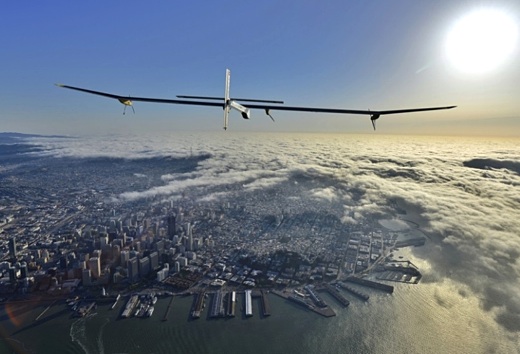By Ugo Bardi on 30 October 2017 for Cassandra's Legacy -
(http://cassandralegacy.blogspot.co.uk/2017/10/biofuels-can-they-save-airlines-from.html)

Image above: It's easier to paint a plane green than to run it on biofuel. Rainy day for a new Boeing 747 that rests on tarmac ready for testing before certification and an airline paint job. From (https://www.flickr.com/photos/1337n00b/847065645/in/photostream/).
"Can the airlines be run on biofuels?" As it often happens, this simple question doesn't have a simple answer. First of all, it is a question that makes sense only in terms of a "sustainable" plane, that is one that doesn't run on fossil fuels. That's a major technological problem.
Whereas cars can be made to run on battery-powered electric motors, the power/weight ratio of the combination is simply unacceptable for a passenger plane that could provide a performance comparable to that of current jet planes.
Hydrogen planes have been proposed, but they are a nightmare for several reasons and it is unlikely that they could become practical in the short and medium term future.
That would leave only biofuels as a "sustainable" fuel that could power the current fleet of jet planes. Indeed, a small number of tests have been carried out showing that it is possible to fly planes using biofuels. But can it be done on the large scale needed to get rid of fossil fuels?
The first problem is whether biofuels are truly carbon-free. Most likely, the current fuels made from crops are not; in the sense that they involve extensive use of fossil fuels for their manufacturing. In many cases, however, even the current generation ("1st generation") of biofuels can provide a significant saving in the use of fossil fuels for the same amount of energy produced.
This is the case, in particular, for ethanol produced from sugarcane in Brazil. But there is a more fundamental question is: what would be the consequences of ramping up biofuel production to the levels needed to power the current airline fleet?
In a recent paper on Nature, Rulli et al. discuss the effect of the large scale cultivation of 1st generation biofuels on various parameters of the world's economy, including the global food supply.
They don't specifically examine the needs of airlines, but we can use their results for analyzing this sector.
First of all, the total amount of jet fuel consumed in the world is reported to be 6,000,000 barrels per day. It corresponds to about 7% of the total world combustible liquids production, but note that jet fuel is a refinery product, so the actual fraction is larger. But let's stick with 7% for lack of better data.
We may consider this value as approximately the fraction of transportation energy used by airlines since crude oil represents 93% of the total.
Rulli et al. estimate that if we were to arrive at a 10% reliance on biofuels for the world's transport, that would leave food for no more than 6.7 billion people and, since the current world population is about 7.6 billion people, almost one billion people would starve.
Now, since the airlines consume about 7% of the world's transport energy, feeding the airlines with biofuels would move us dangerously close to the threshold that would lead to killing a large number of people for the purpose of keeping planes flying. Maybe that won't happen if we are careful, but it is not impossible.
Of course, these data are for first-generation biofuels. There is much enthusiasm for 2nd and 3rd of second and third generation biofuels from cellulosic plant tissues or algae which, theoretically don't impact on the food supply.
Sure, but today the production of these fuels is non-existent or at best negligible. How long will it take to ramp up their production to the levels we are discussing here? And are we sure that they will work as promised?
The problem, here, is not just a technological one. We are dealing with a complex system, the world's economy coupled with the planetary ecosystem. In these systems, you can't change just one thing and leave all the rest unchanged.
Once we start to produce biofuels on a very large scale, it becomes extremely difficult to stop at a certain threshold. If we have a product and a market for it, both tend to expand and it is nearly impossible to stop the expansion of something that generates a profit.
That would bring big problems, to say the least. Rulli et al. estimate that arriving to supply 1st generation biofuels in an amount corresponding to 20% of the transport energy would leave no more than 4.4 billion people alive in the world.
That is, it would kill some 3 billion people.
Or, if dealing with 2nd or 3rd generation biofuels, it would lead to whatever disaster generated by the appropriation for humankind an even larger fraction of the planetary photosynthetic activity than it is done today. The ecosystem has limits, after all.
Unfortunately, it is unlikely that ethical considerations would affect decisions in this field. The system is made in such a way that if producing fuels for the rich is more profitable than producing food for the poor, which is normally the case, the system will produce fuels, even though that implies killing billions of people.
So, we can only hope that biofuels will turn out to be too expensive even for the rich; but that may not be the case.
With so much research and development ongoing, production costs might be lowered enough to turn biofuel into an effective weapon of mass destruction (and I wouldn't be surprised to discover that this is one of the reasons why biofuels are promoted so aggressively in some quarters).
Or, more simply, we may hope that the Seneca Collapse of the world's economy will take care of the "airline problem" once and for all. As I said many times, the Seneca Cliff is not a problem, it is an opportunity.
In this case, it could lead us to develop better transportation technologies; more efficient and more benign for the ecosystem - although probably slower. But that's not a problem, either. It is an opportunity to travel only when you need to, and to enjoy the trip, too!
Some further data on the extent of land needed for the cultivation of biofuels for airlines:
First of all, the total amount of jet fuel consumed in the world is reported to be 6,000,000 barrels per day . It corresponds to about 7% of the total world combustible liquids production. Now, we need to compare the values measured in barrels with the needs of the airlines, measured in liters. A barrel contains 159 liters, so 159*6=1000 makes about 1 billion liters/day, or 3.6x10^11 liters/year.
Let's now consider the most efficient biofuel production: ethanol from Brazil's sugarcane. It can produce 6000 liters/ha per year (http://biotechnologyforbiofuels.biomedcentral.com/articles/10.1186/1754-6834-1-6)
Note that ethanol is not as energy dense as jet fuel. It has only about 70% of the energy density of gasoline http://www.afdc.energy.gov/fuels/fuel_comparison_chart.pdf. Which means that the airlines would consume 3.6*10^11/0.7 = ca. 500 billion liters of ethanol per year.
So, assuming that the whole production of Brazilian ethanol is dedicated to airplanes, we would need more than 80*10^6 hectares (eighty million hectares). The total arable land in Brazil is reported to be: 75 Million ha. (http://www.tradingeconomics.com/brazil/arable-land-hectares-wb-data.html).
It means that the whole agriculture of Brazil should be dedicated only to produce fuel for the airlines.
That is, of course, absurd, but it is also true that the world's total arable land is = 1,407 x10^6 ha (https://en.wikipedia.org/wiki/Arable_land), about 20 times the area available in Brazil.
So, the airlines would need only about 5% of the total which is, by the way, just slightly larger than the global arable area used for biofuel production today (about 4%) (http://www.nature.com/articles/srep22521).
But note also that not all the arable land has the same good productivity as the land used for sugarcane production in Brazil, so the real fraction needed would have to be considerably larger than 5%, probably still less than 10%. How many people would starve if we were to arrive to that, it is impossible to say.



